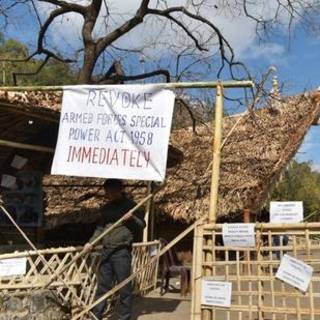Imagine a group of workers returning home in a pick-up truck in the evening after a long day in the coal mines, engaged in conversation, perhaps with cheerful banter, some perhaps dozing off from the tiredness of the day as they speed on, anticipating a hot meal and a normal evening with their families. It’s a daily routine for them, the ordinary folk of Nagaland.
Imagine, out of the dusk, “without any attempt at identification” (according to the state’s highest police official in a signed statement), a deadly hail of bullets tearing into the vehicle and its occupants, ripping through bodies and the pickup’s metal sides in a withering, relentless ambush that kills six of them on the spot. And as their ambushers emerge from the sudden stillness of the evening, they realise to their horror that they have killed a group of unarmed civilians. Two survivors are rushed to a hospital in Dibrugarh, Assam.
The detailed determination of what happened next is for the court of inquiry of the Army whose soldiers were involved in this heinous act, and the state government-instituted Special Investigation Team to ascertain. But the following is what we know from individual and official reports from Mon, Kohima, Dimapur and the dead men’s village of Oting, thanks to the internet before it was shut down.
A group of villagers, worried by the sound of gunfire, rushed to find out why their compatriots were so delayed and saw the bodies tossed onto another pickup under a tarpaulin. A fight broke out between furious villagers and the soldiers.
Seven more were shot, several soldiers injured (one of whom later died) and vehicles torched. Riots broke out the next day in Mon town, headquarters of the district; parts of the Assam Rifles camp were torched. The Assam Rifles fired for one hour at the 600-700 strong crowd leaving one more dead and six wounded by bullets.
This is perhaps the worst incident in decades involving the deaths of civilians at the hands of the Army/security forces. The last one can recall was on March 5, 1995, when troops of the Rashtriya Rifles (RR), mistaking a tire burst in their own convoy for a bomb attack, opened fire indiscriminately. Seven civilians were killed, including two girls aged three and eight, while 22 were seriously injured, including seven minors. The redoubtable Chaman Lal, the then director-general of police (DGP), rushed to the spot and dealt firmly with the RR.
There is a sense of anger and helplessness in Nagaland. People worry that little will come of the inquiries in terms of justice to the victims’ families; Army judicial procedures are not open to the public and soldiers in several states of the Northeast are protected from criminal prosecution by the Armed Forces Special Powers Act (AFSPA), whose sweeping powers are familiar to many.
“How can you have a law that protects attackers? People here feel their dignity and their rights are dispensable, this act has to go,” a distinguished Naga elder said to me on the phone. That is the view of many, a shared collective grief that those of us on the Justice Jeevan Reddy Committee, set up by the Centre in 2004 to review the Act, heard and saw often at our public hearings.
The committee was notified after the shooting death of Manorama Devi by Assam Rifles personnel, an incident that triggered huge outrage in Manipur and across the country. We submitted the report within seven months urging a repeal of the Act but also recommended measures to provide legal cover to security force personnel in difficult operating situations.
Nothing has happened since. The Act has been on the statute books for 63 years and has been upheld as constitutional by the Supreme Court. But, as I have said repeatedly, what is constitutional is not necessarily just.
Nations need laws to counter terrorist movements. But any government, while deciding on the continuance of a law, must review the environment in which the law is being used. Conditions across the Northeast are vastly different from the 1950s and 1960s and even the 1990s. Few soldiers have fallen while on duty since the Naga ceasefire and negotiations began in 1997. That is a major accomplishment, for it has given the people of Nagaland the space for peace and safety, however fractured, even though the frustratingly long-running talks have not concluded.
Last month, insurgents in Manipur ambushed and killed an Army colonel, his family and jawans. Condemnation was swift and unambiguous, as was the rationale that this was exactly why AFSPA was still needed. But it is a double-edged sword, as the Mon tragedy has shown, and why there is strong justification for its revocation.
I seek to place an appeal before the Government of India. Too many mothers have lost their sons and daughters. Too much blood has been spilt. Too many tears of grief have stained the cheeks of children mourning a parent over too many years.
The farm laws were revoked in just over a year in the national interest. AFSPA has been around for 63 years, a creation of the Congress under Jawaharlal Nehru to deal with armed rebellion. Yet the demand for its repeal has echoed from Parliament from the time of its inception. There are enough security laws in place and, when required, special legislation can be passed.
It is time to imagine a new day without the fear and violence embedded in AFSPA for the people of Nagaland and the Northeast. This too is in the national interest and it needs decisive action by a big-hearted, strong leader.
Sanjoy Hazarika is a commentator and author. He was a member of the Justice Jeevan Reddy Committee
The views expressed are personal
Sign on to read the HT ePaper epaper.hindustantimes.com
